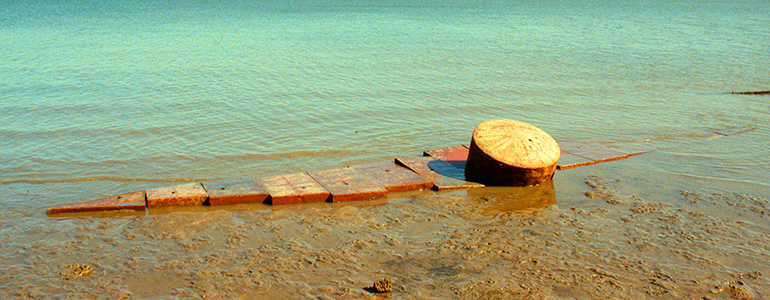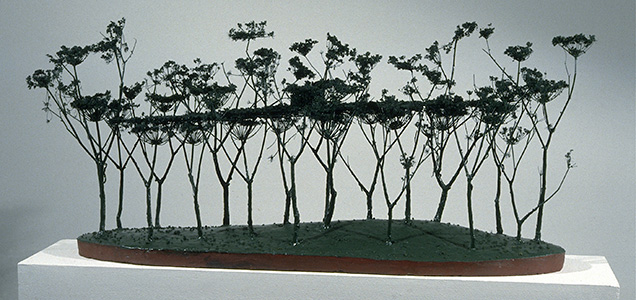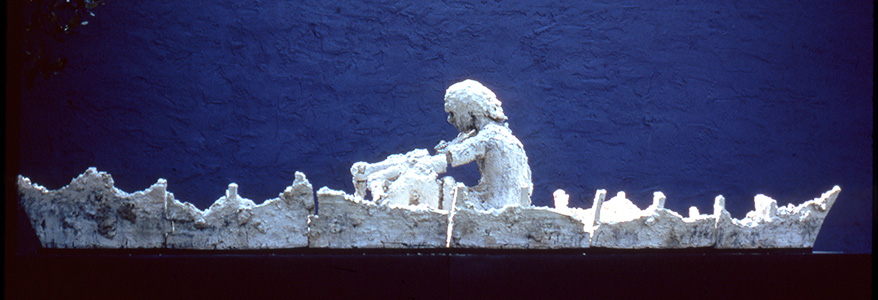Rowboat II
14 ft. / porcelain / Mary McFadden Studio / New York, NY / 1977
collection: American Craft Museum / New York, NY
|
Horsehead Piece
6 ft. / porcelain / 1977
private collection |
Rower
14 ft. / porcelain slip over clay / 1977
collection: Lannon Foundation, Miami, FL / now destroyed
|
Rowboat II
14 ft. / porcelain / Mary McFadden Studio / New York, NY / 1977
collection: American Craft Museum
|
Shoreline Piece
16 ft. / porcelain / 1977
provenance unknown
|
|
Rower
14 ft. / porcelain slip over clay / 1977
collection: Lannon Foundation, Miami, FL / shown installed as part of the Lannon collection / now destroyed |
Late 1970's / Large Works
University of Kentucky / Lexington, KY
In the later 1970's as the relationship to land and seascape evolved, working at a larger scale was of strong interest.
Horsehead Piece; inspired by a scene from a Gunther Grass novel, The Tin Drum, where characters fished for eels that would collect in the head of a horse lowered to the bottom of a river in Prussia.
Two life-sized rowboats of porcelain, who surface simulated a transformation to coral, were constructed in 1977.
Rower, a semi-self portrait as the rower, in a state of decay/transformation, the other, Rowboat II, under a greater state of change, the "rower" now a ghost.
Shoreline: a work designed that when viewed from within its open arc or bay, the extremities of the piece would extend beyond the normal field of vision, mimicking one's visual experience in the landscape.
 |
 |
 |
Land Monitor
approx. 30 ft / steel, refractory cement, sodium silicate/iron oxide surface / 1980
integrated with SF Bay sediment / each segment was ceremonially "killed"
with a hole driven through in the manner of Mimbres funerary pottery.
|
Top: Land Monitor Model
approx. 48 in / painted wood, ceramic with sodium silicate/iron oxide surface / 1980
provenance unknown
Bottom: Land Monitor Model I
approx. 24 in / ceramic / 1980
provenance unknown |
Top: Land Monitor/Wave Model
approx. 36 in / ceramic with paint and sodium silicate/iron oxide surface / 1980
private collection
Bottom: Land Monitor Model I
approx. 24 in / ceramic / 1980
provenance unknown
|
Top: Land Monitor/Volcano Model
approx. 36 in / ceramic with paint and sodium silicate/iron oxide surface / 1980
provenance unknown
Bottom: Land Monitor Model I
approx. 24 in / ceramic / 1980
provenance unknown
|
Top: Land Monitor/Cave Model
approx. 36 in / ceramic with paint and sodium silicate/iron oxide surface / 1980
provenance unknown
Bottom: Land Monitor Model I
approx. 24 in / ceramic / 1980
provenance unknown
|
Top: Land Monitor/Thicket
approx. 36 in / painted wood and ceramic
1980 / provenance unknown
Bottom: Land Monitor/Iron I
approx. 36 in / ceramic with sintered
iron oxide surface / circa 1980
provenance unknown |
Top: Land Monitor/Tableau
approx. 48 in / painted wood and ceramic
1980 / private collection
Bottom: Land Monitor/Iron II
approx. 36 in / ceramic with sintered
iron oxide surface / circa 1980
provenance unknown |
|
Topiary Monitor (for the Treetop Sea)
approx. 36 in / ceramic, wood, paint / model devleloped as a project study/proposal
for a site-based work at the Stuart Collection / UC San Diego, San Diego, CA (not realized) / 1980
private collection, John and Mary Kay Pohanka
|
Late 1970's-Early 1980's / Land Monitors
SFAI / San Francisco, CA / Oakland Studio: Oakland, CA
Monitors/Land Monitors / 1980- 2005
The series of work relating to the monitor as exemplified by the Civil War Monitor ironclad and related vessels, was enhanced by research done at the National Archives and US Naval Historical Center in Washington, DC in the late 1970’s on a range of historical ships. The monitor represented a historical and radical transition in material, form and concept about a ship. The use of iron as a building material took the ship from the organic wooden realm into the inorganic, in the form of iron ore, volcanically transformed and essentialized into a metallic state. The whole life of an iron ship if viewed in a larger process of extraction, distillation, construction, oxidation (in the form of rust) and recombination, a condition of entropy and an analog with metabolism (anabolic and catabolic) become apparent. The characteristically low freeboard and waterline has allusions to landscape in it’s horizontality. In the history of ships the monitor was a critical, evolutionary hybrid of both form and application.
In this body of work the monitor took the form of kiln projects, larger sculptures, a series of models of landscape works and photographs. A significant and formative use of the monitor image or shape, was in the form of a site-specific kiln, Land Monitor/Fired Volcanic Boulder, 1980, here echoing the transformation of heat and material of the kiln as a journey of time and process, returning in time to the birth of the volcanic boulder fired within the form. This project will be examined more in depth in the planned companion volume, Project: Land Kilns. Land Monitor and a series of models for different landscape orientations with their iron oxide structure reference the oxidation of iron at the effective ‘end’ of the ships life and return to native elements. This idea was explored in the photographic series of Civil War ironclads and WWII ships, Orders of Entropy, 2006. Ship studies and proposals of the San Francisco Wharf Complex, 2008-12, as well as other proposals and projects, in part, derive their double-ended form from the Monitor series.
From the treatise - Project: Metafossil / John Roloff / 2013 |
Return to Recent/Selected Projects Page
Return: Shear Zones: Displacements/Permutations over 40+ Years of Ceramic Practice
|





